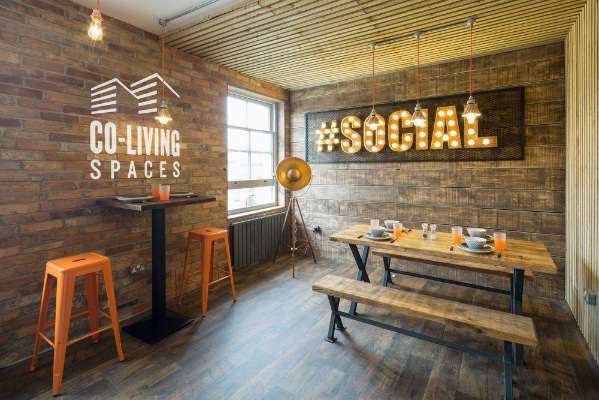Co-living – The New Star of Indian Rental Housing
By, Anuj Puri, Chairman – ANAROCK Property Consultants
Co-living, like car-pooling and co-working, is the result of demand for more evolved rental housing solutions coming from millennials, students and young working professionals whose choices differ vastly from those of previous generations. Currently, this new accommodation option is most popular with young and unmarried millennials aged anywhere between 20-30 years. Professionals who don’t live with their families in the city of work are also considering this option.
Co-living provides such individuals with a way to circumvent the isolation and loneliness that is often integral to a hectic, driven urban experience. While the primary demand for co-living spaces currently comes from such tenants, the concept itself is a lot more ‘accommodating’. In fact, the future may very possibly see demand for co-living solutions coming single seniors, as well.
Cities such as Pune, Bengaluru, Gurgaon, and Mumbai first saw this new concept emerge in force, and it is now also taking root in smaller cities such as Lucknow and Jaipur – basically, in cities with a large student and millennial workforce population.
So, how is co-living Different?
Basically, co-living is an avant-garde rental housing concept wherein fully furnished homes are rented to groups of people who wish to cohabit without the restrictions typical to the more traditional paying guest/hostel-type accommodations for urban singles. Co-living spaces allow their residents to mingle and interact while simultaneously providing privacy at various levels – especially from intrusive landlords.
These are fully managed spaces – much like serviced apartments – but with several extras and customization possibilities included. For instance, tenants can choose private or shared bedrooms. Common kitchens and areas for dining, general interaction and recreation are also integral to co-living units.
As such, co-living spaces are about a lot more than mere lodging and boarding. They offer convenience and an engaging lifestyle for tenants who find the restrictive PG/hostel environment onerous and overly limiting, yet have considerable difficulty with finding accommodation that provides a less encumbered experience.
While paying guest ‘digs’ and hostels are purely about lodging and sometimes boarding, co-living provides an entirely new lifestyle. This far more sophisticated way of living offers a streamlined, hassle-free and invigorating living experience with opportunities to cohabit and interact with others without overbearing scrutiny and ‘house rules’.
While informal iterations of co-living are not new, start-ups such as Oyo Living, Nestaway, CoHo Living, etc. are now bringing in their considerable expertise to offer a professional and more organised way to cater to the demand for less inhibiting encumbered rental living. Apart from the more entrenched hospitality players, a slew of start-ups is also foraying into this new way of rental living – heavily backed by investors such as Goldman Sachs, Sequoia Capital, etc.
As per ANAROCK data, Sequoia Capital invested USD 10 mn in Delhi-based student accommodation platform Stanza Living in 2018. Goldman Sachs and HDFC were also key contributors to student housing last year, solidifying interest of global investors in this new and upcoming segment.
Warburg Pincus, a global Private Equity fund and mid-market chain Lemon Tree Hotels set up a JV in late 2018 to create the first co-living platform focusing on the development of affordable and conveniently located spaces for students and young working professionals across major educational clusters and key office markets in India.
Co-living – A New Investment Asset Class?
While the concept is rapidly being institutionalized by organized players, this does not mean that there is no scope for individual players. By converting a normal apartment of sufficient size into a co-living space, a property owner can capitalize on this vibrant and growing trend in rental housing.
However, there are provisos for the reasonable success of such a venture, largely related to location and rental cost.
Urban singles invariably prefer to live close to their workplace/education centre. For instance, the key areas in Bangalore seeing a spurt of co-living spaces include Bellandur, HSR Layout, Electronic City, Nagawara, Domlur and Mahadevapura. Most of these areas are home to IT professionals who work in and around the areas or those that work in the existing start-up offices within or near the locality.
As per ANAROCK data, IT-driven markets like Electronic City, Mahadeva Pura and Nagawara offer comparatively lower rentals than start-up driven localities like HSR Layout, Koramangala and Indira Nagar. The rentals in these IT-driven markets are 15-20% less compared to those dominated by start-up professionals.
Potential ROI on Co-living Spaces
Going by the recent trends, co-living may offer a higher rental yield of as much as 8-11%, as compared to the current average yield of 1-3% in residential properties. It is definitely paving the way for a new asset class in real estate investing. Interestingly, co-living spaces can also bring down the average cost of living for consumers by as much as 10-15% on the back of optimal real estate utilization and the economies of scale.
Co-living certainly offers an opportunity for fairly steady and higher-than-average rental revenue. Though there is bound to be some churn in tenants, the reliability and comfort of a particular unit or set of units spread rapidly by word-of-mouth. An individual property owner who has transformed and tenanted one or two apartments into co-living units can expect more customers coming in via reference.
Not Without Challenges
Making such a play is not as easy as it may initially seem. There are certain inherent challenges:
As opposed to traditional rental accommodations such as paying guest digs or outright rental flats, co-living spaces call for much higher investment – both in terms of one-time setup costs as well as the regular maintenance and servicing of the space.
Operating a co-living space calls for a certain degree of knowledge about the specific requirements of this new niche residential segment.
It is also not always easy to get the required permissions from a particular housing society to set up a co-living facility.
The location needs to be just right, especially in terms of connectivity and proximity to major educational institutions and workplace hubs.
The size of the unit and the amenities provided both within the housing society and within the unit itself have to be just right.
Getting tenants is not always easy. The relatively higher rentals of co-living spaces in comparison to the traditional PGs and hostels can be a put-off. Many inward-migrating young professionals find high rentals rates unaffordable and non-sustainable in the long run.
The trend of co-living is still in its fledgling phase in India and has only selective takers so far. Given that the residential segment is seeing reduced investor interest in the present market scenario, it will take a little while for this segment to gain the kind of momentum it has seen in more developed countries.
That said, co-living is definitely here to stay and will find increasing takers – not only because of the aspirations of young professionals and students but also the evolving mindset of society in general.
INDIAN RENTAL HOUSING SCENARIO
Today the overall share of rental housing could be anywhere between 35-45% of the total Indian residential real estate segment. It is definitely increasing, particularly in urban centres which account for nearly 70% of the total rental market.
As per IMF’s last estimate two years ago, India’s residential rental market was worth more than US $20 billion, comprising of $13.5 billion in urban areas, $0.8 billion in rural areas, and $5.7 billion of vacant non-resident Indian property brokerage.
The Government Census maintains that nearly 28% of urban households lived in rented houses in 2011. However, this number is definitely much higher now. It must be borne in mind that the rental housing market is almost exclusively a private one, driven by myriad small-scale providers. This makes it more difficult to chart than residential sales.




